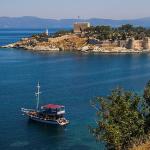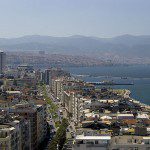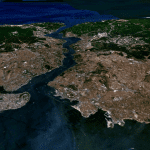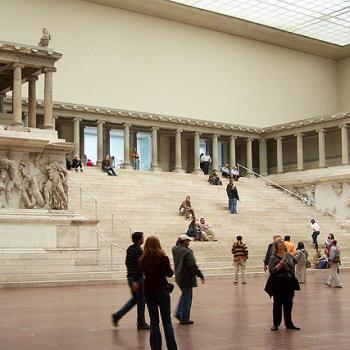
(Wikimedia Commons public domain photo by Casalmaggiore Provincia)
I’ve failed to call your attention to an article of mine that recently appeared in Meridian Magazine. So I’m going to call your attention to it right now. This article recently appeared in Meridian Magazine: “A New Film About Prophetic Succession After the Death of Joseph Smith, Now in Production.”

Our first visit this morning, driving past Ephesus, was to the traditional House of the Virgin Mary. Legend has it that the apostle John brought Jesus’s widowed and bereaved mother Mary with him to Asia Minor, where she spent the rest of her life and where she enjoyed considerable success as a missionary.
The house was identified in the nineteenth century, based on visions reported by the Roman Catholic nun Anne Catherine Emmerich (1774–1824), which were published after her death. The Catholic Church has never officially commented on the authenticity of the site, but Pope Leo XIII blessed pilgrimage to it in 1896, Pope Pius XII elevated the house to the status of a Holy Place in 1951, and that privilege was made permanent by Pope St. John XXIII in 1961. Pope St. Paul VI actually visited the shrine in June 1967, Pope St. John Paul II visited it in November 1979 (and “beatified” Anne Catherine Emmerich—the step just below [or just before] sainthood—in October 2004), and the late Pope Benedict XVI visited it during his four-day pastoral tour of Turkey in November 2006.
It’s a beautiful place, high in the hills or mountains near Ephesus and surrounded by pine trees and other greenery. The view from the men’s room — those men who have been to Meryemena, the site of the purported house of the Virgin Mary, will know what I mean — is very pretty.
I confess, though, to having doubts about the authenticity of the site and about the whole idea of Mary having come to live in Ephesus. It seems to me that a peasant girl from a rural Jewish village in Judea would have felt terribly displaced by being moved to so foreign a place as the pagan area near Ephesus, and that language barriers would have limited any missionary efforts on her part. Moreover, Meryemena is up in wooded hills quite distant from Ephesus or anybody else. And the house itself seems much too recent to date from the first century. On the other hand, I’m open to the unlikely possibility that the site is authentic, and I certainly don’t rule out the possibility that Blessed Anne Catherine Emmerich might genuinely have been inspired. For one thing, Mary might possibly have been in real danger had she stayed near her home. Moreover, Jesus specifically entrusted John with her care from the cross:
When Jesus therefore saw his mother, and the disciple standing by, whom he loved, he saith unto his mother, Woman, behold thy son!
Then saith he to the disciple, Behold thy mother! And from that hour that disciple took her unto his own home. (John 19:26-27)
After breakfast this morning, we headed to Laodicea.
That the apostle Paul wrote an “Epistle to the Laodiceans” is indicated by Colossians 4:16:
And when this epistle is read among you, cause that it be read also in the church of the Laodiceans; and that ye likewise read the epistle from Laodicea (ἐκ Λαοδικείας, ek Laodikeas). (Colossians 4:16)
However, that letter is lost. And I’ve always wondered how our Evangelical “Bible Alone” Protestant friends would react if a demonstrably authentic text of that lost letter were ever to be found. Would they accept it? Would they rejoice at its discovery? Would they reject it as unnecessary and “unbiblical”?
Laodicea is the place that is addressed as follows in Revelation 3:16: “I know thy works, that thou art neither cold nor hot: I would thou wert cold or hot.” The Laodiceans, it seems, were lukewarm.
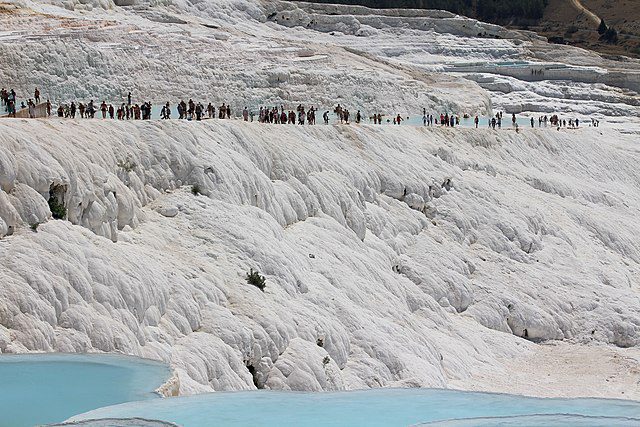
(Wikimedia Commons public domain photo)
Nearby Hierapolis, however, was not lukewarm. Its hot springs were a major source of the Laodiceans’ water, which had apparently assumed room temperature by the time it arrived. (This was rather unusual; generally one of the first considerations for the location of an ancient city was an easily accessible source of good water.) Another suggestion, though, is that it might have been the contrast between the hot springs of Hierapolis and the cold mountain-springs of nearby Colossae that gave Laodicea the reputation of being “lukewarm.”
We visited ancient Hierapolis and its so-called “Cotton Castle” (Turkish Pamukkale), a natural wonder of gigantic white waterfalls, stalactites, and natural pools formed over the centuries by the passage of waters laden with limestone salts from the town’s hot springs. (It is reminiscent of Yellowstone’s Mammoth Hot Springs, back in their heyday.). Pamukkale is the name that the town goes by today, but its ancient name Hierapolis, with polis being the standard Greek word for “city,” seems to have come from an ancient woman named Hiera. Sometimes, though, it was interpreted to mean “holy city” (which is linguistically plausible) or re-written as Hieropolis (“city of temples”).
It is said that the apostle Philip spent the last period of his life in Hierapolis and that he was martyred and buried there. And there has been news on that front just this summer: As a 6 July 2023 item from the Biblical Archaeology Society put it: “Tomb of Apostle Philip Found: Discovery made at Hierapolis, one of the major Christian sites in Turkey.” (https://www.biblicalarchaeology.org/daily/biblical-sites-places/biblical-archaeology-sites/tomb-of-apostle-philip-found/)
An appendix to the ancient, apocryphal, anonymous book of the Acts of Philip is entitled “Of the Journey of Philip the Apostle: From the Fifteenth Act Until the End, and Among Them the Martyrdom.” This appendix a rather elaborate (and probably at least partially fictionalized) account of Philip’s martyrdom in the city of Hierapolis. According to this account, Philip managed to convert the wife of the proconsul of the city by means of both his preaching and a miraculous healing. However, the proconsul was not pleased. Quite the contrary: He was enraged. So he had Philip and others tortured. Philip and Bartholomew were then crucified upside down but, even so, Philip would not be silenced. Indeed, he preached from his cross, which so moved many of the onlookers that they released Bartholomew from his punishment. But Philip insisted that they not release him — a rather odd note, that — and so he died on the cross. But it needs to be noted that tradition also specifies that Philip was martyred by beheading, rather than by crucifixion. Perhaps he died twice? In either case, he is said to have met his death once or twice in Hierapolis.
The sunset from Hierapolis was very pretty. Alas, though, time precluded a visit to nearby Colossae (Κολοσσαί). Yes, this is city to whom the epistle to the Colossians was written:
Epaphras, who is one of you, a servant of Christ, saluteth you, always labouring fervently for you in prayers, that ye may stand perfect and complete in all the will of God. For I bear him record, that he hath a great zeal for you, and them that are in Laodicea, and them in Hierapolis. (Colossians 4:12-13)
Moreover, we know of Philemon that he was a wealthy Christian, possibly the bishop or branch president of the house church that met in his home in Colossae. The epistle of Paul that bears his name is only 335 words in the original Greek:
Paul, a prisoner of Jesus Christ, and Timothy our brother, unto Philemon our dearly beloved, and fellowlabourer, and to our beloved Apphia, and Archippus our fellowsoldier, and to the church in thy house. (Philemon 1:1-2)
Laodicea and Hierapolis and Colossae all seem to have been fairly receptive to the message of Christianity at a very early period—perhaps because they had significant populations of Jews at that time. But there may have been other rich philosophical and theological currents running through the area. A notable suggestion of that is Epictetus, who was born into slavery in Hierapolis somewhere around 50 AD. He became one of the very greatest of the ancient Stoic philosophers, and Stoicism was one of the most important philosophical movements of antiquity. It’s even possible to imagine that he may have been influenced by Christians in his neighborhood. He once wrote about the perfect emissary or missionary of Stoicism that such an individual’s bed is the ground, that his covering is the sky, and that he is obligated to love those who do him injury.
This was the last day of the main Interpreter Foundation tour, and a few of our number headed off from Hierapolis to the Denizli Airport, whence they were to fly to Istanbul and then, the next day, home to the United States of America (or somewhere else). The rest of us are staying in Pamukkale for the optional tour extension. And, in fact, two more people are joining us.
I’m always saddened and a bit depressed when people leave these tours or when the tours actually end. We get to know them fairly well during our brief time together. We see them at every meal. So to have them depart is . . . well, it’s a bit like death, in a way. Not to be overly dramatic, but it is.
Posted from Pamukkale, Denizli, Türkiye


